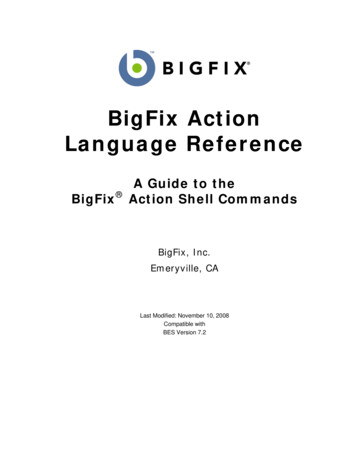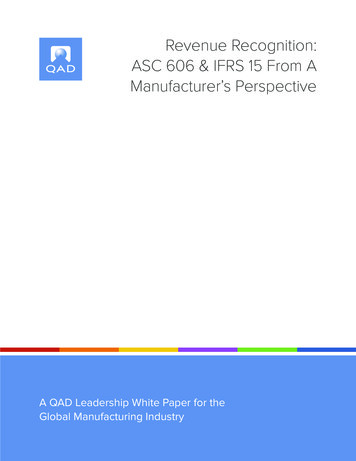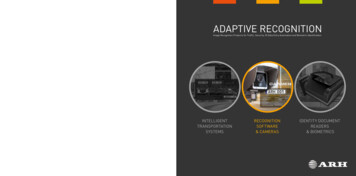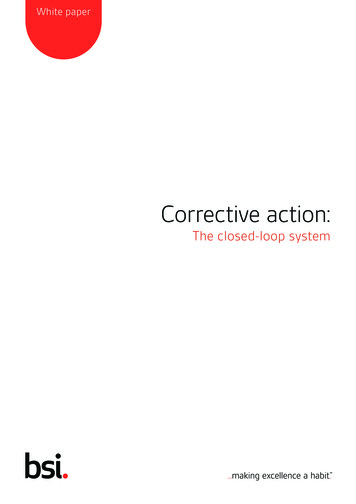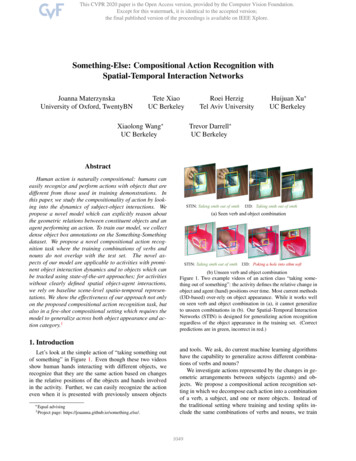
Transcription
Something-Else: Compositional Action Recognition withSpatial-Temporal Interaction NetworksJoanna MaterzynskaUniversity of Oxford, TwentyBNTete XiaoUC BerkeleyRoei HerzigTel Aviv UniversityHuijuan Xu UC BerkeleyTrevor Darrell UC BerkeleyXiaolong Wang UC BerkeleyAbstractHuman action is naturally compositional: humans caneasily recognize and perform actions with objects that aredifferent from those used in training demonstrations. Inthis paper, we study the compositionality of action by looking into the dynamics of subject-object interactions. Wepropose a novel model which can explicitly reason aboutthe geometric relations between constituent objects and anagent performing an action. To train our model, we collectdense object box annotations on the Something-Somethingdataset. We propose a novel compositional action recognition task where the training combinations of verbs andnouns do not overlap with the test set. The novel aspects of our model are applicable to activities with prominent object interaction dynamics and to objects which canbe tracked using state-of-the-art approaches; for activitieswithout clearly defined spatial object-agent interactions,we rely on baseline scene-level spatio-temporal representations. We show the effectiveness of our approach not onlyon the proposed compositional action recognition task, butalso in a few-shot compositional setting which requires themodel to generalize across both object appearance and action category.1STIN: Taking smth out of smthI3D: Taking smth out of smth(a) Seen verb and object combinationSTIN: Taking smth out of smth I3D: Poking a hole into sthm soft(b) Unseen verb and object combinationFigure 1. Two example videos of an action class “taking something out of something”: the activity defines the relative change inobject and agent (hand) positions over time. Most current methods(I3D-based) over-rely on object appearance. While it works wellon seen verb and object combination in (a), it cannot generalizeto unseen combinations in (b). Our Spatial-Temporal InteractionNetworks (STIN) is designed for generalizing action recognitionregardless of the object appearance in the training set. (Correctpredictions are in green, incorrect in red.)1. IntroductionLet’s look at the simple action of “taking something outof something” in Figure 1. Even though these two videosshow human hands interacting with different objects, werecognize that they are the same action based on changesin the relative positions of the objects and hands involvedin the activity. Further, we can easily recognize the actioneven when it is presented with previously unseen objects Equaladvisingpage: https://joaanna.github.io/something else/.1 Projectand tools. We ask, do current machine learning algorithmshave the capability to generalize across different combinations of verbs and nouns?We investigate actions represented by the changes in geometric arrangements between subjects (agents) and objects. We propose a compositional action recognition setting in which we decompose each action into a combinationof a verb, a subject, and one or more objects. Instead ofthe traditional setting where training and testing splits include the same combinations of verbs and nouns, we train1049
and test our model on the same set of verbs (actions) butcombine them with different object categories, so that testedverb and object combinations have never been seen duringtraining time (Figure 1 (b)).This problem turns out to be very challenging for heretofore state-of-the-art action recognition models. Computervision researchers have developed deep networks with temporal connections for action recognition by using RecurrentNeural Networks with 2D Convolutions [76, 11] and 3DConvNets [7, 74, 61, 63]. However, both types of modelshave difficulty in this setting; our results suggest that theycannot fully capture the compositionality of action and objects. These approaches focus on extracting features for thewhole scene and do not explicitly recognize objects as individual entities; scene-level convolutional operators mayrely more on spatial appearance rather than temporal transformations or geometric relations, since the former aloneare often highly predictive of the action class [54, 3].Recently, researchers have investigated building spatialtemporal graph representations of videos [67, 68, 9, 25]leveraging recently proposed graph neural networks [38].These methods take dense object proposals as graph nodesand learn the relations between them. While this certainlyopens a door for bringing relational reasoning in video understanding, the improvement over the 3D ConvNet baselines is not very significant. Generally, these methods haveemployed non-specific object graphs based on a large set ofobject proposals in each frame, rather than sparse semantically grounded graphs which model the specific interactionof an agent and constituent objects in an action.In this paper, we propose a model based on a sparse andsemantically-rich object graph learned for each action. Wetrain our model with accurately localized object boxes in thedemonstrated action. Our model learns explicit relations between subjects and objects; these turn out to be the key forsuccessful compositional action recognition. We leveragestate-of-the-art object detectors to accurately locate the subject (agent) and constituent objects in the videos, performmulti-object tracking on them and form multiple trackletsfor boxes belonging to the same instance. As shown in Figure 1, we localize the hand, and the objects manipulated bythe hand. We track the objects over time and the objectsbelonged to the same instance are illustrated by the boxeswith the same color.Our Spatial-Temporal Interaction Network (STIN) reasons on candidate sparse graphs found from these detection and tracking results. Our model takes the locations andshapes of objects and subject in each frame as inputs. It firstperforms spatial interaction reasoning on them by propagating the information among the subjects and objects, thenwe perform temporal interaction reasoning over the boxesalong the same tracklet, which encodes the transformationof objects and the relation between subjects and objects intime. Finally, we compose the trajectories for the agent andthe objects together to understand the action. Our modelis designed for activities which have prominent interactiondynamics between a subject or agent (e.g., hand) and constituent objects; for activities where no such dynamics areclearly discernible with current detectors (e.g., pouring water, crushing paper), our model falls back to leverage baseline spatio-temporal scene representations.We introduce the Something-Else task, which extendsthe Something-Something dataset [20] with new annotations and a new compositional split. In our compositionalsplit, methods are required to recognize an action when performed with unseen objects, i.e., objects which do not appear together with this action at training time. Thus methods are trained on “Something”, but are tested on their ability to generalize to “Something-Else”. Each action categoryin this dataset is described as a phrase composed with thesame verb and different nouns. We reorganize the datasetfor compositional action recognition and model the dynamics of inter-object geometric configurations across time peraction. We investigate compositional action recognitiontasks in both a standard setting (where training and testingare with the same categories) and a few-shot setting (wherenovel categories are introduced with only a few examples).To support these two tasks, we collect and will release annotations on object bounding boxes for each video frame.Surprisingly, we observe even with only low dimensionalcoordinate inputs, our model can show comparable resultsand improves the appearance-based models in few-shot setting by a significant margin.Our contributions include: (i) A Spatial-Temporal Interaction Network which explicitly models the changes of geometric configurations between agents and objects; (ii) Twonew compositional tasks for testing model generalizabilityand dense object bounding box annotations in videos; (iii)Substantial performance gain over appearance-based modelon compositional action recognition.2. Related WorkAction recognition is of central importance in computer vision. Over the past few years, researchers havebeen collecting larger-scale datasets including Jester [44],UCF101 [59], Charades [56], Sports1M [35] and Kinetics [37]. Boosted by the scale of data, modern deep learning approaches, including two-stream ConvNets [57, 66],Recurrent Neural Networks [76, 12, 47, 5] and 3D ConvNets [31, 7, 14, 73, 62, 63, 13], have shown encouragingresults on these datasets. However, a recent study in [77]indicates that most of the current models trained with theabove-mentioned datasets are not focusing on temporal reasoning but the appearance of the frames: Reversing theorder of the video frames at test time will lead to almostthe same classification result. In light of this problem, theSomething-Something dataset [20] is introduced to recog-1050
nize action independent of the object appearance. To pushthis direction forward, we propose the compositional actionrecognition task for this dataset and provide object bounding box annotations.The idea of compositionality in computer vision originates from Hoffman’s research on Parts of Recognition [26]. Following this work, models with pictorial structures have been widely studied in traditional computer vision [15, 78, 29]. For example, Felzenszwalb et al. [15] proposes a deformable part-based model that organizes a set ofpart classifiers in a deformable manner for object detection.The idea of composing visual primitives and concepts hasalso been brought back in the deep learning community recently [64, 45, 36, 1, 32, 28]. For example, Misra et al. [45]propose a method to compose classifiers of known visualconcepts and apply this model to recognize objects with unseen combinations of concepts. Motivated by this work, wepropose to explicitly compose the subjects and objects in avideo and reason about the relationships between them torecognize the action with unseen combinations of verbs andnouns.The study of visual relationships has a long history incomputer vision [23, 75, 51] and early work investigatedcombining object and motion features for action recognition [52, 46]. Recent works have shown relational reasoningwith deep networks on images [19, 27, 55, 33]. For example, Gkioxari et al. [19] proposes to accurately detect therelations between the objects together with state-of-the-artobject detectors. The idea of relational reasoning has alsobeen extended in video understanding [67, 68, 70, 25, 60,18, 2, 69, 30]. For instance, Wang et al. [68] apply a spacetime region graph to improve action classification in cluttered scenes. Instead of only relying on dense “objectness”region proposals, Wu et al. [70] further extend this graphmodel with accurate human detection and reasoning over alonger time range. Motivated by these works, we build ourspatial-temporal interaction network to reason about the relations between subjects and objects based on accurate detection and tracking results. Our work is also related to theVisual Interaction Network [69], which models the physicalinteractions between objects in a simulated environment.To further illustrate the generalizability of our approach,we also apply our model in a few-shot setting. Few-shotimage recognition has become a popular research topicin recent years [16, 58, 65, 8, 17, 48]. Chen et al. [8]has re-examined recent approaches in few-shot learningand found a simple baseline model which is very competitive compared to meta-learning approaches [16, 40, 53].Researchers have also investigated few-shot learning invideos [22, 6]. Guo et al. [22] propose to perform KNN onobject graph representations for few-shot 3D action recognition. We adopt our spatial-temporal interaction networkfor few-shot video classification, by using the same learn-Action ClassificationTemporal tialInteraction(a) Spatial-Temporal Interaction NetworkSpatial Interaction[!" , (!# ! )/2]FC!"!#! FC[! , (!" !# )/2](b) Spatial Interaction ModuleFigure 2. (a) The Spatial-Temporal Interaction Network (STIN):our model operates on object-centric features and performs spatialinteraction reasoning for individual frames and temporal interaction reasoning to obtain a classification decision. (Different colorsrepresent different objects in this figure.) (b) The Spatial Interaction Module: Given a set of object features in one frame, weaggregate them together with the information about their relativeposition by applying Eq. 1 to update each object feature.ing scheme as the simple baseline mentioned in [8].3. Spatial-Temporal Interaction NetworksWe present Spatial-Temporal Interaction Networks(STIN) for compositional action recognition. Our modelutilizes a generic detector and tracker to build objectgraph representations that explicitly include hand and constituent object nodes. We perform spatial-temporal reasoning among these bounding boxes to understand how the relations between subjects and objects change over time for agiven action (Figure 2). By explicitly modeling the transformation of object geometric relations in a video, our modelcan effectively generalize to videos with unseen combinations of verbs and nouns as demonstrated in Figure 3.3.1. Object-centric RepresentationGiven a video with T frames, we first perform objectdetection on these video frames, using a detector which detects hands and generic candidate constituent objects. Theobject detector is trained on the set of all objects in the trainsplit of the dataset as one class, and all hands in the training data as a second class. Assume that we have detected1051
N instances including the hands and the objects manipulated by the hands in the scene, we then perform multiobject tracking to find correspondences between boxes indifferent video frames. We extract two types of feature representation for each box: (a) bounding box coordinates; and(b) an object identity feature. Both of these features are designed for compositional generalization and avoiding objectappearance bias.Bounding box coordinates. One way to represent an object and its movement is to use its location and shape. Weuse the center coordinate of each object along with its heightand width as a quadruple, and forward it to a Multi-LayerPerceptron (MLP), yielding a d-dimensional feature. Surprisingly, this simple representation alone turns out to behighly effective in action recognition.Object identity embedding. In addition to the object coordinate feature, we also use a learnable d-dimensional embedding to represent the identities of objects and subjects.We define three types of embedding: (i) subject (or agent)embedding, i.e., representing hands in an action; (ii) objectembedding, i.e., representing the objects involved in the action; (iii) null embedding, i.e., representing dummy boxesirrelevant to the action. The three embeddings are initialized from an independent multivariate normal distribution.The identity embedding can be concatenated together withbox coordinate features as the input to our model. Since theidentity (category) of the instances is predicted by the objectdetector, we can combine coordinate features with embedding features accordingly. We note that these embeddingsdo not depend on the appearance of input videos.We find that combining the box coordinate feature withthe identity feature significantly improves the performanceof our model. Since we are using a general object embedding for all kinds of objects, this helps the model to generalize across different combinations of verbs and nouns in acompositional action recognition setting.Robustness to Unstable Detection. In cases where objectdetector is not reliable, where the number of detected objects is larger than a fix number N , we can perform objectconfiguration search during inference. Each time we randomly sample N object tracklets and forward them to ourmodel. We perform classification based on the most confident configuration which has the highest score. However, inour current experiments, we can already achieve significantimprovement without this process.3.2. Spatial-temporal interaction reasoningGiven T video frames and N objects per frame,we denote the set of object features as X (x11 , ., x1N , x21 , ., x2N , ., xTN ), where xti represents thefeature of object i in frame t. Our goal is to perform spatialtemporal reasoning in X for action recognition. As illustrated in Figure 2(a), we first perform spatial interactionreasoning on objects in each frame, then we connect thesefeatures together with temporal interaction reasoning.Spatial interaction module. We perform spatial interaction reasoning among the N objects in each frame. Foreach object xti , we first aggregate the features from the otherN 1 objects by averaging them, then we concatenate theaggregated feature with xti . This process can be representedas,1 X txj ]),(1)f (xti ) ReLU(WfT [xti ,N 1j6 iwhere [, ] denotes concatenation of two features in the channel dimension and WfT is learnable weights implementedby a fully connected layer. We visualize this process in Figure 2(b) in the case of N 3.Temporal interaction module. Given the aggregated feature of objects in each frame, we perform temporal reasoning on top of the features. As tracklets are formed and obtained previously, we can directly link objects of the sameinstance across time. Given objects in the same tracklet, wecompute the feature of the tracklet as g(x1i , ., xTi ): We firstconcatenate the object features, then forward the combinedfeature to another MLP network. Given a set of temporalinteraction results, we aggregate them together for actionrecognition as,p(X) WpT h({g(x1i , ., xTi )}Ni 1 ),(2)where h is a function combining and aggregating the information of tracklets. In this study, we experiment withtwo different approaches to combine tracklets: (i) Designh as a simple averaging function to prove the effectivenessof our spatial-temporal interaction reasoning. (ii) Utilizenon-local block [67] as the function h. The non-local blockencodes the pairwise relationships between every two trajectory features before averaging them. In our implementation, we adopt three non-local blocks succeeded by convolutional kernels. We use Wp as our final classifier withcross-entropy loss.Combining video appearance representation. Besidesexplicitly modeling the transformation of relationships ofsubjects and objects, our spatial-temporal interaction modelcan be easily combined with any video-level appearancerepresentation. The presence of appearance features helpsespecially the action classes without prominent inter-objectdynamics. To achieve this, we first forward the video framesto a 3D ConvNet. We follow the network backbone applied in [68], which takes T frames as input and extractsa spatial-temporal feature representation. We perform average pooling across space and time on this feature representation, yielding a d-dimensional feature. Video appearance representations are concatenated with object representations h({g(x1i , ., xTi )}Ni 1 ), before fed into the classifier.1052
Moving [something] and [something]away from each otherPushing [something] offof [something](marker, marker)(apple, chair)(domino, folder)(cup, glass)Figure 3. Annotated examples of the Something-Something V2 dataset. Understanding the action from the visual appearance of the entirescene is challenging because we can perform the same action using arbitrary objects, however, observing the relative change of the locationand positioning of the object and hands in the scene concisely captures the interaction.4. The Something-Else TaskTo present the idea of compositional action recognition,we adopt the Something-Something V2 dataset [20] andcreate new annotations and splits within it. We name theaction recognition on the new splits as the “Something-Elsetask”.The Something-Something V2 dataset contains 174 categories of common human-object interactions. Collected viaAmazon Mechanical Turk in a crowd-sourced manner, theprotocol allows turkers to pick an action category (verb),perform and upload a video accordingly with arbitrary objects (noun). The lack of constraints in choosing the objectsnaturally results in large variability in the dataset. There are12, 554 different object descriptions in total. The originalsplit does not consider the distribution of the objects in thetraining and the testing set, instead, it asserts that the videosrecorded by the same person are in either training or testing set but both. While this setting reduces the environmentand individual bias, it ignores the fact that the combinationof verbs and nouns presented in the testing set may havebeen encountered in the training stage. The high performance obtained in this setting might indicate that modelshave learned the actions coupled by typical objects occurring, yet does not reflect the generalization capacity of models to actions with novel objects.Compositional Action Recognition. In contrast to randomly assigning videos into training or testing sets, wepresent a compositional action recognition task. In our setting, the combinations of a verb (action) and nouns in thetraining set do not exist in the testing set. We define a subset of frequent object categories as those appearing in morethan 100 videos in the dataset. We split the frequent objectcategories into two disjoint groups, A and B. Besides objects, action categories are divided into two groups 1 and2 as well. In [20] these categories are organized hierarchically, e.g., “moving something up” and “moving somethingdown” belong to the same super-class. We randomly as-# Classes Training ValidationTask 957,876FS-Base88112,39712,4678643049,822FS-Novel 5-S8686043,954FS-Novel 10-STable 1. Comparison and statistics of various tasks on theSomething-Something V2. FS: few-shot; n-S: n-shot.sign each action category into one of two groups, and at thesame time enforce that the actions belonging to the samesuper-class are assigned into the same group.Given the splits of groups, we combine action group 1with object group A, and action group 2 with object groupB, to form the training set, termed as 1A 2B. The validation set is built by flipping the combination into 1B 2A.Different combinations of verbs and nouns are thus dividedinto training or testing splits in this way. The statistics ofthe training and the validation sets under the compositionalsetting are shown in the second row of Table 1.Few-shot Compositional Action Recognition. The compositional split challenges the network to generalize overobject appearance. We further consider a few-shot datasetsplit setting indicating how well a trained action recognition model can generalize to novel action categories withonly a few training examples. We assign the action classesin the Something-Something V2 dataset into a base splitand a novel split, yielding 88 classes in the base set and86 classes in the novel set. We randomly allocate 10% ofthe videos from the base set to form a validation set andthe rest of the videos as the base training set. We then randomly select k examples for each category in the novel setwhose labels are present in the training stage, and the remaining videos from the novel set are designated as the validation set. We ensure that the object categories in k-shottraining videos do not appear in the novel validation set. Inthis way, our few-shot setting additionally challenges models to generalize over object appearance. We term this task1053
STIN: Pretending to pick something upI3D: Pulling something onto somethingSTIN: Uncovering somethingI3D: Covering something with somethingSTIN: Moving something closer to somethingI3D: Pretending to take something out of somethingSTIN: Putting something onto somethingI3D: Pretending to take something out of somethingFigure 4. Predictions of STIN and I3D models. Correct predictions are in green, incorrect in red. STIN can keep tracking the relationsbetween subjects and objects as they change over time in complicated actions.as few-shot compositional recognition. We set k to 5 or 10in our experiments. The statistics are shown in Table 1.Bounding-box annotations. We annotated 180,049 videosof the Something-Something V2 dataset. For each video,we provide a bounding box of the hand (hands) and objects involved in the action. In total, 8,183,381 frames with16,963,135 bounding boxes are annotated, with an averageof 2.41 annotations per frame and 94.21 per video. Otherlarge-scale video datasets use bounding box annotation, inapplications involving human-object interaction [10], actionrecognition [21], and tracking [49].5. ExperimentsWe perform experiments on the two proposed tasks:compositional action recognition and few-shot compositional action recognition.5.1. Implementation DetailsDetector. We choose Faster R-CNN [50, 71] with FeaturePyramid Network (FPN) [42] and ResNet-101 [24] backbone. The model is first pre-trained with the COCO [43]dataset, then finetuned with our object box annotations onthe Something-Something dataset. During finetuning, onlytwo categories are registered for the detector: hand and object involved in action. The object detector is trained withthe same split as the action recognition model. We set thenumber of objects in our model as 4. If fewer objects arepresented, we fill a zero vector to represent the object.Tracker. Once we have the object detection results, we apply multi-object tracking to find correspondence betweenthe objects in different frames. The multi-object tracker isimplemented based on minimalism to keep the system assimple as possible. Specifically, we use the Kalman Filter [34] and Kuhn-Munkres (KM) algorithm [39] for tracking objects as [4]. At each time step, the Kalman Filterpredicts plausible whereabouts of instances in the currentframe based on previous tracks, then the predictions arematched with single-frame detections by the KM algorithm.5.2. SetupTraining details. The MLP in our model contains 2 layers.We set the dimension of MLP outputs d 512. We train allour models for 50 epochs with learning rate 0.01 using SGDwith 0.0001 weight decay and 0.9 momentum, the learningrate is decayed by the factor of 10 at epochs 35 and 45.Methods and baselines. The experiments aim to explorethe effectiveness of different components in our SpatialTemporal Interaction Networks for compositional actionrecognition, we compare the following models: STIN: Spatial-Temporal Interaction Network withbounding box coordinates as input. Average poolingis used as aggregation operator h. STIN OIE: STIN model not only takes box coordinates but also Object Identity Embeddings (OIE). STIN OIE NL: Use non-local operators for aggregation operator h in STIN OIE. I3D: A 3D ConvNet model with ResNet-50 backboneas in [68], with state-of-the-art performance. STRG: Space-Time Region Graph (STRG) model introduced in [68] with only similarity graph. I3D STIN OIE NL: Combining the appearancefeature from the I3D model and the feature from theSTIN OIE NL model by joint learning. I3D, STIN OIE NL: A simple ensemble modelcombining the separately trained I3D model and thetrained STIN OIE NL model. STRG, STIN OIE NL: An ensemble model combining the STRG model and the STIN OIE NLmodel, both trained separately.1054
modelTRN [77]TRN Dual Attention [72]TSM [41]STIN OIEI3DI3D STIN OIEOur experiments with STIN use either ground-truthboxes or the boxes detected by the object detector. The presented score is from a single clip in each video, which is acenter cropped in time.Visualization. Figure 4 visualizes examples of how ourSTIN model and I3D model performs. Our STIN modelcan keep tracking how the hand moves to understand theaction whereas I3D is confused when the activity resemblesother action class.top-577.680.387.478.781.484.4Table 2. Results on the original Something-something V2dataset. Ground-truth annotations are applied with STIN.modelSTINSTINSTIN OIESTIN OIE NLI3DI3DI3D STIN OIE NLI3D, STIN OIE NL5.3. Original Something-Something SplitWe first perform our experiments on the originalSomething-something V2 split. We test our I3D baselinemodel and the STIN model with ground-truth object bounding boxes for action recognition. As shown in Table 2,our I3D baseline is much better than the recently proposedTRN [77] model. The result of our STIN OIE model withground-truth annotations is reported in Table 2. We can seethat with only coordinates inputs, our performance is comparable with TRN [77]. After combining with the I3D baseline model, we can improve the baseline model by 5%. Thisindicates the potential of our model and bounding box annotations even for the standard action recognition 75.279.379.383.572.279.483.2(a) Compositional action recognition with ground-truths.modelSTINSTIN OIESTIN OIE NLI3DSTRGI3D STIN OIE NLI3D, STIN OIE NLSTRG, STIN OIE NL5.4. Compositional Action RecognitionWe further evaluate our model on the compositional action recognition task. We first experiment with using theground-truth object bounding boxes for the STIN model,as reported in Table 3a. To illustrate the difficulty of ourcompositional task, we also report the results on a “shuffled” split of the videos: We use the same candidate videosbut shuffle them randomly and form a new training andvalidation set. Note that the number of training videos isthe same as the compositional split. T
on the proposed compositional action recognition task, but also in a few-shot compositional setting which requires the model to generalize across both object appearance and ac-tion category.1 1. Introduction Let’s look at the simple action of “taking something ou


